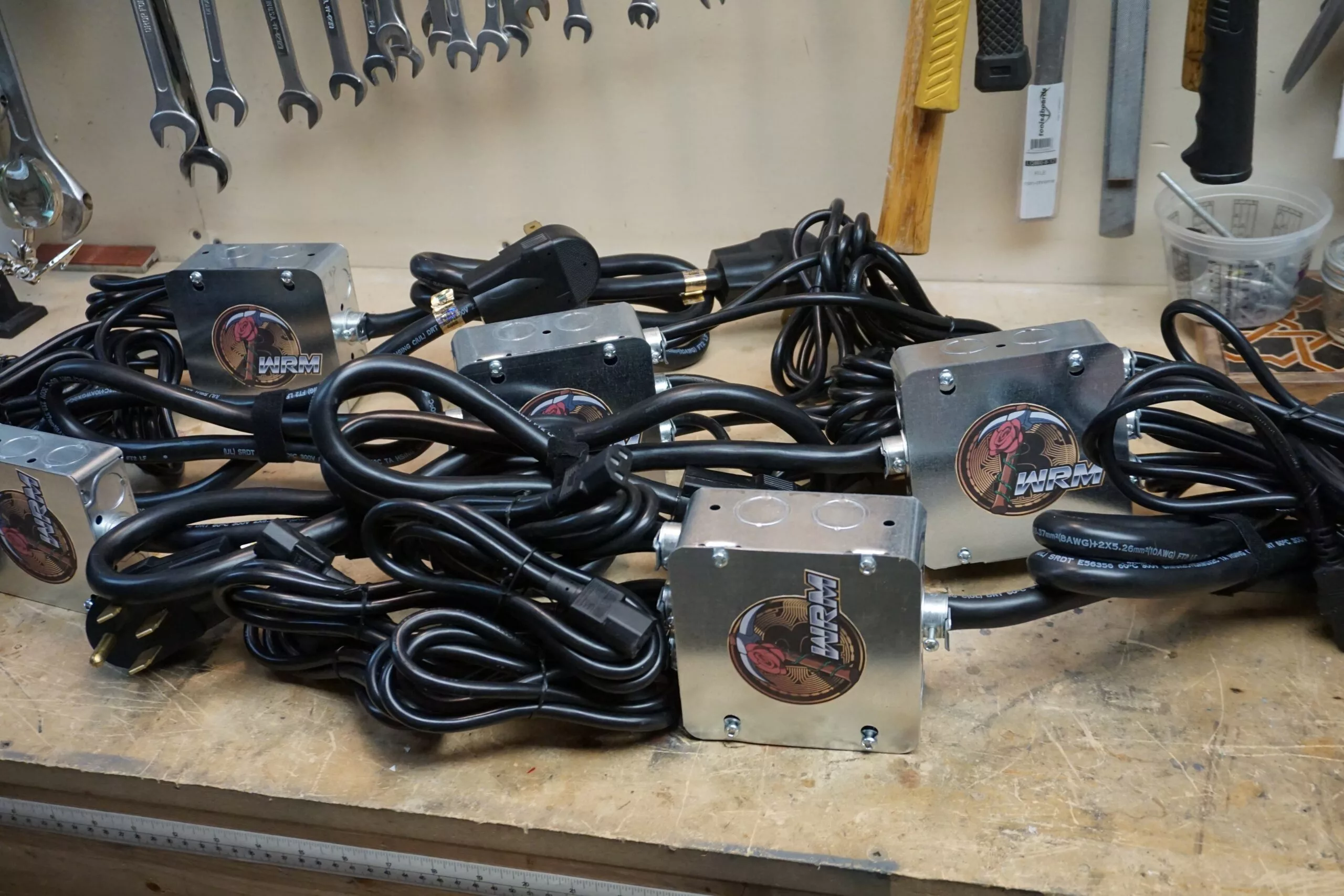Selecting a PDU is a more complex process than many may imagine. There are so many variations that depend on the needs of the buyer, which is why there isn’t really a single go-to solution. These needs are described in the sections below:
The 80% Rule
The 80% rule is a rule of thumb in the mining community that dictates amount of power that should be run through a circuit breaker. Because of the continuous heavy current that ASIC miners draw, they can often flip a breaker even if they don’t theoretically use enough power to do so. Why? I’ll save you the science behind how a breaker works, but the TLDR is that household breakers are designed for household applications, Where the load is drawn intermittently rather than consistently. Below is a table showing the usable ampacity for each commonly available breaker type for your reference:
| Breaker Ampacity (A) | Usable Ampacity for Mining (A) | Usable Wattage at 240V (W) |
| 15 | 12 | 2880 |
| 20 | 16 | 3840 |
| 30 | 24 | 5760 |
| 40 | 32 | 7680 |
| 50 | 40 | 9600 |
As you can see, following the 80% rule does significantly decrease your per-circuit capacity, but following it is a must in order to avoid flipping breakers, downtime, and even fire hazards.
Converting Watts/Volts/Amps
Many who aren’t familiar with electrical calculations get confused about amps vs. volts vs. watts. Don’t be alarmed if you are as well, as all three unit types are quite simple to understand.
One common method to gain understanding is to think of an electrical wire as a pipe, and the electricity flowing through it as a fluid. With this model, the “speed” of the fluid would represent voltage, and the “pressure” of the fluid would represent amperage. The combined result of the 2 would be the amount of fluid flowing, which would represent amperage.
This model helps us understand the formula:
P = I * V
Where P represents Power in Watts, I represents amperage in Amps, and V represents Voltage in Volts. This formula can be manipulated to calculate any electrical specification needed to wire up your PDUs and miners.
If you don’t know what voltage powers your mining facility, you can always ask your electrician, or measure it yourself by using a multimeter. Most Canadian and American homes operate on 120/240V, but in rare cases such as high density residential, the voltage is 120/208V.
Single Phase vs. Three Phase
Choosing whether you need a single or three-phase PDU isn’t always as simple as finding out what power comes out our your transformer/into your facility. There are a few things to consider that can save you a both a hassle and money.
The first, is that having 3 phase power does not necessarily create a need for a three-phase PDU. You can simply use single phase PDUs hooked up from phase to phase, or from phase to neutral. This can be beneficial if the phases need specific balancing, and can save some cost. For example, you have a large load already present on one of your phases and need to balance it out with a load from your miners on the other phases. Additionally, it may in some cases be less expensive to buy three single-phase PDUs vs a single three-phase PDU, especially if you already have existing single phase wiring in place.
Rated Amperage (Single-Phase)
The right amperage for your PDU will depend entirely on which ASIC miners you plan to power. Since the calculations must consider a number of factors, we have devised some tables with the most common voltages for mining in North America for your convenience:
208V:
| Ampacity | Wattage (80%) | 1st Gen | 2nd Gen | 3rd Gen |
| 30 | 4992 | 4 | 2 | 1 |
| 50 | 8320 | 6 | 3 | 2 |
| 63 | 10483 | 8 | 4 | 3 |
| 80 | 13312 | 10 | 5 | 4 |
| 125 | 20800 | 15 | 8 | 6 |
240V:
| Ampacity | Wattage (80%) | 1st Gen | 2nd Gen | 3rd Gen |
| 30 | 5760 | 4 | 2 | 2 |
| 50 | 9600 | 7 | 4 | 3 |
| 63 | 12096 | 9 | 5 | 4 |
| 80 | 15360 | 11 | 6 | 5 |
| 125 | 24000 | 18 | 9 | 7 |
LEGEND:
- 1st Gen: Antminer S9 etc. (~1350W)
- 2nd Gen: Antminer S17 etc. (~2550W)
- 3rd Gen: Antminer S19 etc. (~3250W)
Rated Amperage (Three-Phase)
This portion of the guide covers 3 phase PDUs that operate from Phase to Phase. For 3 phase PDUs that operate on phase to neutral, you can simply use single phase calculations, and multiply the wattage result by 3.
When PDUs are wired phase to phase, the amperage equivalent must be multiplied by the square root of 3. Like the previous section, we’ll save you the hassle, and include a table for the common 120/208V Delta or Wye system:
208/120V:
| Ampacity | Wattage (80%) | 1st Gen | 2nd Gen | 3rd Gen |
| 30 | 8646 | 6 | 3 | 2 |
| 50 | 14411 | 10 | 6 | 4 |
| 63 | 18157 | 13 | 7 | 5 |
| 80 | 23057 | 17 | 9 | 7 |
| 125 | 36027 | 27 | 14 | 11 |
LEGEND:
- 1st Gen: Antminer S9 etc. (~1350W)
- 2nd Gen: Antminer S17 etc. (~2550W)
- 3rd Gen: Antminer S19 etc. (~3250W)
Surge Protection
A power surge is defined as:
“A fast, short duration electrical transient in voltage (voltage spikes), current (current spikes), or transferred energy (energy spikes) in an electrical circuit”, Wikipedia
A power surge can be caused by many factors including lightning, infrastructure failure, static electricity, and many more. A PDU with surge protection protects against voltage surges. This means that its internal surge protector will either short (providing a path of least resistance for the surge), or open (disconnecting the circuit entirely) when a surge in voltage that exceeds its safe threshold.
Surge protection is useful for regions with “dirty” power where outages and infrastructure failure are common. While miners do have some integrated protection against current spikes, a voltage surge that goes unprotected can easily kill your miners’ power supplies and in some cases, even the hash boards and control boards.
The conclusion: surge protection is generally only needed when mining in a rural area. When mining inside an urban area such as at home, or in an industrial park, the power generally stays well within safe levels, meaning that surge protection is an extra cost that isn’t necessary, but can still be chosen for peace of mind.
Main Breaker
Some PDUs include a main breaker. This means that they have an integrated breaker for additional protection. Generally, PDUs are attached to a circuit that already has a breaker in the panel, so why would one need a PDU with another breaker?
PDUs with an integrated breaker are often only used with a circuit that has a larger breaker in the main panel. For example, you have a circuit that has a single 100A breaker in the panel, and the circuit has 2 50A outlets. In this use case, PDUs with an integrated breaker would be a smart addition in order to ensure that the input wire and plug of the PDU (which would be rated for 50A) never exceed 50A in total.
Individual Fusing
Some PDUs offer individual fusing for each miner. This means that each outlet will be ensured to never exceed its specified Ampacity. This option provides the utmost safety for your facility and mining equipment. However, the main disadvantage is that these PDUs are generally very cost prohibitive and hard to come by for smaller ampacity PDUs. Read more about unfused PDUs here.


Leave a Reply